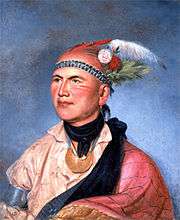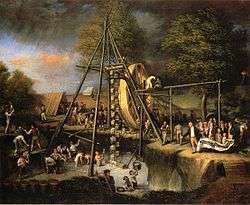Charles Willson Peale
| Charles Willson Peale | |
|---|---|
 Charles Willson Peale (1741–1827) self-portrait from c. 1782–85 | |
| Born |
April 15, 1741 Chester, Province of Maryland, British America |
| Died |
February 22, 1827 (aged 85) Philadelphia, Pennsylvania, United States of America |
| Resting place | Saint Peter's Episcopal Churchyard, Philadelphia |
| Nationality | American |
| Known for | Painting |

Charles Willson Peale (April 15, 1741 – February 22, 1827) was an American painter, soldier, scientist, inventor, politician and naturalist. He is best remembered for his portrait paintings of leading figures of the American Revolution, and for establishing one of the first museums in the United States.
Early life
Peale was born in 1741 in Chester, Queen Anne's County, Maryland, the son of Charles Peale and his wife Margaret. He had a younger brother, James Peale (1749–1831). Charles became an apprentice to a saddle maker when he was thirteen years old. Upon reaching maturity, he opened his own saddle shop; however, when his Loyalist creditors discovered he had joined the Sons of Liberty, they conspired to bankrupt his business. He was also, not very good at saddle making. He then tried fixing clocks and working with metals, but both of these endeavors failed as well. He then took up painting.
Career as a painter
Finding that he had a talent for painting, especially portraiture, Peale studied for a time under John Hesselius and John Singleton Copley. John Beale Bordley and friends eventually raised enough money for him to travel to England to take instruction from Benjamin West. Peale studied with West for three years beginning in 1767, afterward returning to America and settling in Annapolis, Maryland. There, he taught painting to his younger brother, James Peale, who in time also became a noted artist.
American Revolution

Peale's enthusiasm for the nascent national government brought him to the capital, Philadelphia, in 1776, where he painted portraits of American notables and visitors from overseas. His estate, which is on the campus of La Salle University in Philadelphia, can still be visited. He also raised troops for the War of Independence and eventually gained the rank of captain in the Pennsylvania militia by 1776, having participated in several battles. While in the field, he continued to paint, doing miniature portraits of various officers in the Continental Army. He produced enlarged versions of these in later years. He served in the Pennsylvania state assembly in 1779–1780, after which he returned to painting full-time.
Peale was quite prolific as an artist. While he did portraits of scores of historic figures (such as James Varnum, Benjamin Franklin, John Hancock, Thomas Jefferson, and Alexander Hamilton), he is probably best known for his portraits of George Washington. The first time Washington sat for a portrait was with Peale in 1772, and they had six other sittings; using these seven as models, Peale produced altogether close to 60 portraits of Washington. In January 2005, a full-length portrait of Washington at Princeton from 1779 sold for $21.3 million, setting a record for the highest price paid for an American portrait.
One of his most celebrated paintings is The Staircase Group (1795), a double portrait of his sons Raphaelle and Titian, painted in the trompe l'oeil style.[1] It is in the collection of the Philadelphia Museum of Art.

Peale Museum
Peale had a great interest in natural history, and organized the first U.S. scientific expedition in 1801. These two major interests combined in his founding of what became the Philadelphia Museum, later known as Peale's American Museum.
It housed a diverse collection of botanical, biological, and archaeological specimens. Most notably, the museum contained a large variety of birds which Peale himself acquired, and in many instances mounted, having taught himself taxidermy. In 1792, Peale initiated a correspondence with Thomas Hall, of the Finsbury Museum, City Road, Finsbury, London proposing to purchase British stuffed items for his museum. Eventually, an exchange system was established between the two, whereby Peale sent American birds to Hall in exchange for an equal number of British birds. This arrangement continued until the end of the century. The Peale Museum was the first to display a mastodon skeleton (which in Peale's time were referred to as mammoth bones; these common names were amended by Georges Cuvier in 1800, and his proposed usage is that employed today) that Peale found in New York State. Peale worked with his son to mount the skeleton for display.

The display of the "mammoth" bones entered Peale into a long-standing debate between Thomas Jefferson and Comte de Buffon. Buffon argued that Europe was superior to the Americas biologically, which was illustrated through the size of animals found there. Jefferson referenced the existence of these "mammoths" (which he believed still roamed northern regions of the continent) as evidence for a greater biodiversity in America. Peale's display of these bones drew attention from Europe, as did his method of re-assembling large skeletal specimens in three dimensions.
The museum was among the first to adopt Linnaean taxonomy. This system drew a stark contrast between Peale's museum and his competitors who presented their artifacts as mysterious oddities of the natural world.
The museum underwent several moves during its existence. At various times it was located in several prominent buildings including Independence Hall and the original home of the American Philosophical Society.
The museum would eventually fail, in large part because Peale was unsuccessful at obtaining government funding. After his death, the museum was sold to, and split up by, showmen P. T. Barnum and Moses Kimball.[2]
Marriage and family

In 1762, Peale married Rachel Brewer (1744–1790), who bore him ten children, most named for Peale's favorite artists, male and female. The sons included Raphaelle Peale (1774–1825), Rembrandt Peale (1778–1860), who was another famous portrait painter and museum owner/operator in Baltimore, and scientific inventor and businessman, and Rubens Peale (1784–1865). Among the daughters: Angelica Kauffman Peale (named for Angelica Kauffman, Peale's favorite female painter) married Alexander Robinson, her daughter Priscilla Peale wed Dr. Henry Boteler,[3] and Sophonisba Angusciola Peale (named for Sofonisba Anguissola) married Coleman Sellers.
After Rachel's death in 1790, Peale married Elizabeth de Peyster (d. 1804) the next year. With his second wife, he had six additional children. One son, Franklin Peale, born on October 15, 1795, became the Chief Coiner at the Philadelphia Mint. Their youngest son, Titian Ramsay Peale (1799–1885), became an important naturalist and pioneer in photography. Their daughter, Elizabeth De Peyster Peale (1802–57), married William Augustus Patterson (1792–1833) in 1820. Peale himself died on February 22, 1827, and was buried at the Saint Peter's Episcopal Church in Philadelphia.[4]
Hannah More, a Quaker from Philadelphia, married Peale in 1804, becoming his third wife. She helped raise the younger children from his previous two marriages.
Peale's slave, Moses Williams, was also trained in the arts while growing up in the Peale household and later became a professional silhouette artist.[5]
%2C_by_Charles_Willson_Peale_(1741_-_1827).jpg)
In 1810, Peale purchased a farm in Germantown where he intended to retire. Peale named this estate 'Belfield', and cultivated extensive gardens there. After Hannah's death in 1821, Peale lived with his son Rubens and sold Belfield in 1826.
Expertise
A Renaissance man, Peale had expertise not only in painting but also in many diverse fields, including carpentry, dentistry, optometry, shoemaking, and taxidermy. In 1802, John Isaac Hawkins patented the second official physiognotrace, a mechanical drawing device, and partnered with Peale to market it to prospective buyers. Peale sent a watercolor sketch of the physiognotrace, along with a detailed explanation, to Thomas Jefferson. The drawing is now held with the Jefferson Papers in the Library of Congress.[6]
Around 1804, Peale obtained the American patent rights to the polygraph from its inventor John Isaac Hawkins, about the same time as the purchase of one by Thomas Jefferson. Peale and Jefferson collaborated on refinements to this device, which enabled a copy of a handwritten letter to be produced simultaneously with the original.

Peale wrote several books, among which were An Essay on Building Wooden Bridges (1797) and An Epistle to a Friend on the Means of Preserving Health (1803). Peale named all of his sons for artists or scientists, and taught them to paint. Three of them, Rembrandt, Raphaelle, and Titian, became noted artists in their own right.
He was the brother-in-law of Nathaniel Ramsey, a delegate to the Congress of the Confederation.
Legacy and honors
- Three of his sons, Rembrandt Peale, Raphaelle Peale, and Titian Peale, became noted artists as well.
- The World War II cargo Liberty Ship S.S. Charles Willson Peale was named in his honor.
Notable works
 Portrait of George Washington, 1779
Portrait of George Washington, 1779 Miniature portrait of George Washington, Charles W. Peale (1775–76)
Miniature portrait of George Washington, Charles W. Peale (1775–76) Nancy Hallam as Fidele in Shakespeare's Cymbeline (1771)
Nancy Hallam as Fidele in Shakespeare's Cymbeline (1771) John and Elizabeth Lloyd Cadwalader (1772)
John and Elizabeth Lloyd Cadwalader (1772) Henrietta Maria Bordley at age 10 (1773), Honolulu Academy of Arts
Henrietta Maria Bordley at age 10 (1773), Honolulu Academy of Arts George Washington in uniform, as colonel of the First Virginia Regiment (1772)
George Washington in uniform, as colonel of the First Virginia Regiment (1772) Armand Tuffin de La Rouerie (1782)
Armand Tuffin de La Rouerie (1782) Arthur St. Clair (1782)
Arthur St. Clair (1782) Mrs. David Forman and Child, ca. 1785. Brooklyn Museum
Mrs. David Forman and Child, ca. 1785. Brooklyn Museum James Mitchell Varnum, (1804)
James Mitchell Varnum, (1804) Nathanael Greene (1783)
Nathanael Greene (1783) Benjamin Lincoln (1784)
Benjamin Lincoln (1784) Henry Knox (1784)
Henry Knox (1784) Timothy Matlack (c. 1790)
Timothy Matlack (c. 1790) Thomas Jefferson (1791)
Thomas Jefferson (1791) John Hazelwood (178?)
John Hazelwood (178?).jpg) Charles Pettit (1792)
Charles Pettit (1792) Joseph Brant (1797)
Joseph Brant (1797) James Wilkinson (1797)
James Wilkinson (1797) Exhuming the First American Mastodon (1806)
Exhuming the First American Mastodon (1806) Meriwether Lewis (1807)
Meriwether Lewis (1807) William Clark (1810)
William Clark (1810) George Washington at Battle of Princeton (1784)
George Washington at Battle of Princeton (1784) Anne Catherine Hoof Green (1769)
Anne Catherine Hoof Green (1769) Miniature of John Laurens (1780)
Miniature of John Laurens (1780) Mrs. James Smith and Grandson (1776) (see William Smith)
Mrs. James Smith and Grandson (1776) (see William Smith)
See also
References
- ↑ Deceptions and Illusions: Five Centuries of Trompe l'Oeil Painting, National Gallery of Art
- ↑ Alexander, Edward P. (1995). Museum Masters: Their Museums and Their Influence. Rowman Altamira. pp. 43–72.
- ↑ From Slave Ship to Harvard: Yarrow Mamout and the History of an African ... p. 149.
- ↑ Charles Willson Peale at Find a Grave
- ↑ DuBois Shaw, Gwendolyn. "Moses Williams: Cutter of Profiles", American Philosophical Society, Retrieved 28 March 2015.
- ↑ "Paper Profiles: American Portrait Silhouettes" http://206.180.235.133/jaic/articles/jaic41-03-001_5.html[]
External links
| Wikimedia Commons has media related to Charles Willson Peale. |
- Reynolda House Museum of American Art: Mr. and Mrs. Alexander Robinson, 1795
- Charles Willson Peale and His World from the Metropolitan Museum of Art
- Peale-Sellers Family Collection at the American Philosophical Society
- Portrait of General David Foreman, Berkshire Museum
- The Winterthur Library Overview of an archival collection on Charles Willson Peale.
- History of Peale at Belfield, now the grounds of La Salle University, Philadelphia, PA
- Union List of Artist Names, Getty Vocabularies. ULAN Full Record Display for Charles Willson Peale. Getty Vocabulary Program, Getty Research Institute. Los Angeles, California.
- James Madison, Bust Portrait Miniature by Peale from the *Rare Book and Special Collection Division at The Library of Congress
- Catherine "Kitty" Floyd, Bust Portrait Miniature by Peale from the Rare Book and Special Collection Division at The Library of Congress
| de Peyster family tree |
|---|
|